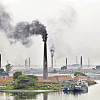Air pollution in Bangladesh killed 2.36 lakh people in 2021

Air pollution has become the leading cause of death in Bangladesh, outpacing fatalities from high blood pressure, poor diet and tobacco use, found a new study.
In 2021, at least 236,000 lives were lost in Bangladesh due to air pollution, according to the fifth edition of the State of Global Air report, which was released yesterday.
In contrast, there were 200,000 deaths linked to high blood pressure, 130,100 deaths linked to tobacco use and 130,400 deaths linked to poor diet.
Children in Bangladesh are particularly vulnerable to air pollution: the country ranked fifth globally in 2021 in the total number of deaths among children under the age of five due to air pollution.
As many as 19,000 children under five years old died due to air pollution, said the report, which was produced by the State of Global Air Initiative, a collaboration between the Health Effects Institute (HEI) and the Institute for Health Metrics and Evaluation's Global Burden of Disease project in partnership with Unicef.
India tops the list with 169,000 deaths in children under 5, followed by Nigeria (114,000), Pakistan (68,000) and Ethiopia (31,000).
"In the last 20 years, we have talked a lot about air pollution but when it comes to action, we rarely see any action -- even the interventions that we saw are very insignificant," said Abdus Salam, one of the reviewers of the study.
The study focuses on the danger of both indoor and outdoor pollution and the vulnerability of children due to indoor air pollution in Bangladesh, said Salam, a professor of chemistry at Dhaka University.
As much as 36 percent of preterm births in Bangladesh in 2021 were linked to exposure to air pollution.
Air pollution impacts children's health in many ways -- from pregnancy through early childhood -- through impacts on newborns including preterm birth, as well as through lower respiratory infections and asthma in children,said Pallavi Pant, head of global health at HEI.
The study found South Asia to be the most polluted region in the world in terms of air: about 18 percent of the total deaths in the region are linked to air pollution.
Bangladesh also featured in the top 20 countries with the highest outdoor PM2.5 exposures.
More than 92 percent of the country's population live in areas that exceed the least stringent interim target for PM2.5 (35 µg/m3) from the World Health Organisation, the report said.
Exposure to household air pollution caused by the use of solid fuels for cooking is also linked to the development of cataracts, a debilitating disease that affects many across South Asia, Pant told The Daily Star.
Across South Asia, residential solid fuel use continues to be an important contributor to outdoor PM2.5, together with energy, industry, agriculture and transportation sectors.
"It is promising to see progress including reductions in PM2.5 levels and exposure to household air pollution over the last few years. However, exposures to various pollutants remain high in much of South Asia, and the data brings into focus the need for sustained and science-based local and regional action to improve air quality," said Pant, who oversaw the report's release.
While there is a silver lining with the stabilisation and even reduction of annual average PM2.5 levels of air pollutants at the national level, another threat looms large: ozone pollution, according to the report.
For the first time, this year's report includes exposure levels and related health effects of nitrogen dioxide (NO2), including the impact of NO2 exposures on the development of childhood asthma.
Since 2000, deaths linked to exposure to ozone have more than doubled, with 15,000 deaths in 2021 compared with 6,200 deaths in 2000.
Traffic exhaust is a major source of NO2, which means densely populated urban areas, particularly in high-income countries, often see the highest levels of NO2 exposure and health impacts.

 For all latest news, follow The Daily Star's Google News channel.
For all latest news, follow The Daily Star's Google News channel. 





Comments